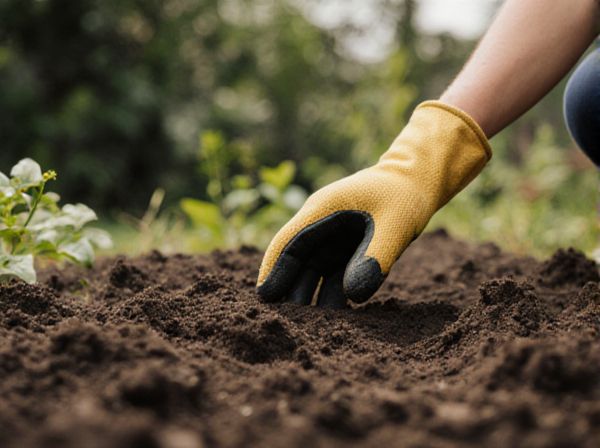
Soil beds vs raised benches Illustration
Soil beds provide a natural growing environment that enhances root development and supports a diverse range of plants by retaining moisture and nutrients effectively. Raised benches improve air circulation, reduce soil-borne diseases, and facilitate easier access for planting and maintenance, making them ideal for intensive cultivation. Choosing between soil beds and raised benches depends on crop type, space availability, and management goals in greenhouse production.
Table of Comparison
| Feature | Soil Beds | Raised Benches |
|---|---|---|
| Plant Growth | Natural rooting depth, better for deep-rooted plants | Controlled medium, ideal for varied crops and delicate seedlings |
| Drainage | Dependent on soil type; can retain excess moisture | Enhanced drainage with raised structure, reducing waterlogging |
| Maintenance | High labor for weeding and soil health management | Lower maintenance, easy to manage and clean |
| Soil Temperature | Variable, influenced by ground temperature | Warms up faster, extending growing season |
| Pest Control | Higher risk of soil-borne pests and diseases | Reduced risk with better airflow and controlled medium |
| Accessibility | Requires bending or kneeling, less ergonomic | Ergonomic height, easier for planting and harvesting |
| Cost | Lower initial cost, uses existing soil | Higher setup cost due to materials and structure |
Introduction to Greenhouse Growing Methods
Soil beds in greenhouses offer natural soil ecosystem benefits and retain moisture effectively, making them ideal for crops with deep root systems. Raised benches improve air circulation and drainage while reducing soil-borne diseases, enhancing plant health and ease of access for maintenance. Choosing between soil beds and raised benches depends on crop type, greenhouse design, and desired cultivation outcomes.
What Are Soil Beds in Greenhouses?
Soil beds in greenhouses are ground-level planting areas where crops grow directly in the native soil, providing natural insulation and moisture retention. These beds allow for deep root development and benefit from the earth's existing microbial ecosystem, promoting plant health and growth. Soil beds are often preferred for crops that require stable temperature and moisture conditions, enhancing overall yield and quality.
Understanding Raised Benches in Greenhouses
Raised benches in greenhouses improve soil drainage and prevent waterlogging by elevating plants above ground level. They enhance root aeration, reduce soil compaction, and promote healthier plant growth compared to traditional soil beds. These benches also facilitate better pest control and simplify maintenance tasks such as watering and harvesting.
Pros and Cons of Soil Beds
Soil beds in greenhouses offer natural nutrient cycles and better water retention, promoting healthier root development and plant growth. However, challenges include potential soil-borne diseases, pests, and difficulty in controlling soil temperature and moisture uniformly. While soil beds are cost-effective and sustainable, they require more labor-intensive management compared to raised benches.
Advantages and Disadvantages of Raised Benches
Raised benches in greenhouses enhance drainage and prevent soil compaction, promoting healthier root development and increased plant growth. These benches improve air circulation around plants, reducing the risk of fungal diseases compared to traditional soil beds. However, raised benches require higher initial investment and may limit rooting depth, which can be a disadvantage for deep-rooted crops.
Comparing Plant Health: Soil Beds vs Raised Benches
Soil beds promote natural root development and microbial activity, enhancing plant health through improved nutrient availability and moisture retention. Raised benches offer better drainage and reduced soil compaction, minimizing root diseases and facilitating easier pest management. Both systems influence plant health distinctly, with soil beds supporting robust growth in heavy crops and raised benches optimizing conditions for delicate seedlings.
Space Efficiency in Soil Beds and Raised Benches
Soil beds in greenhouses maximize space efficiency by allowing direct ground planting, which supports extensive root growth and higher plant density. Raised benches optimize vertical space by elevating crops, improving accessibility and airflow while reducing soil compaction. Choosing between soil beds and raised benches depends on balancing space utilization with crop type and greenhouse layout.
Cost Analysis: Soil Beds vs Raised Benches
Soil beds generally require lower initial investment due to minimal construction materials and simpler setup processes, making them more cost-effective for small-scale greenhouse operations. Raised benches incur higher upfront costs related to materials like metal or wood frames and elevated structures but offer improved drainage, pest control, and ease of maintenance, potentially reducing long-term labor and crop loss expenses. Evaluating overall expenses involves balancing initial outlays for raised benches against ongoing operational savings compared to soil beds.
Maintenance and Management Requirements
Soil beds in greenhouses demand frequent weeding, soil aeration, and moisture monitoring to maintain optimal plant growth, while raised benches offer improved drainage and easier access, reducing physical strain during maintenance. Raised benches also minimize soil-borne diseases by elevating plants above ground level, leading to less frequent soil replacement and pest management. Regular management of soil beds can be labor-intensive due to compaction and nutrient depletion, whereas raised benches streamline routine tasks such as pruning, harvesting, and irrigation control.
Choosing the Right Option for Your Greenhouse
Soil beds offer natural root growth and moisture retention, making them ideal for crops that thrive in native soil conditions, while raised benches provide better drainage, aeration, and pest control, enhancing plant health in greenhouses with limited floor space. Choosing the right option depends on your greenhouse's climate control, crop type, and maintenance preferences. Raised benches optimize accessibility and reduce soil-borne diseases, whereas soil beds are cost-effective and promote natural soil ecosystems.
Soil beds vs raised benches Infographic

 gardendif.com
gardendif.com